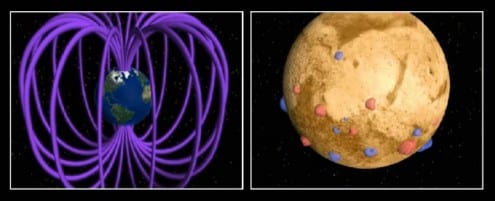Mars Express and the magnetism of the red planet
By Oli Usher, on 8 July 2014
Planet Earth is a vast magnet with a strong magnetic field surrounding it. As well as making compasses point north and guiding solar particles to the poles, creating the aurorae, the magnetic field protects our atmosphere. Shielded from the solar wind and from solar and galactic cosmic rays, Earth’s atmosphere is thick and life-sustaining and is not at any risk of being blown into space.
Mars – an Earth-like planet in many other respects – has lacked such a global magnetic field for about 3.8 billion years. Its atmosphere is thin – less than 1% of the atmospheric pressure we have on Earth – leaving a cold, hostile and barren surface.

The magnetic fields of Earth (left) and Mars (right). Earth has a strong, planet-wide magnetic field that shields our atmosphere from the Solar wind. Mars has only small localised areas of magnetism called crustal fields, meaning its atmosphere interacts directly with the Solar wind. Credit: NASA/GSFC (public domain)
The lack of magnetic field makes Mars different from Earth in other respects too. In fact, in some ways Mars behaves much like a comet: since the Solar wind interacts directly with the atmosphere a comet-like tail of gas is constantly being blown off the planet (albeit not to the extent of a comet as it passes near the Sun).
UCL researchers have studied the behaviour of Mars and its interaction with the Solar wind for many years, including through participation in the European Space Agency’s Mars Express mission. Orbiting Mars since 2003, the mission has been a huge success (unlike the Beagle 2 lander it carried), and like many missions it carries UCL hardware contributions. This comes in the form of a sensor in the ASPERA-3 instrument, for which UCL carried out calibration and blackening (to prevent internal reflections degrading observations) prior to launch.
The ASPERA-3 instrument has helped UCL scientists study Martian magnetic anomalies called crustal fields. These are small, localised magnetic fields on the surface of Mars which interact with the Solar wind and material escaping the Martian atmosphere. It has also observed how the faint ‘tail’ of material streaming from Mars has photoelectrons caused by the Sun.
UCL is also involved in the exploration of the Martian surface – it leads the team building the main camera for the ExoMars Rover, Europe’s first Mars rover, which touches down in 2019.
The Alfvén conference, being held at UCL this week, is bringing together experts from around the world in the field of electrical, magnetic and plasma interactions in the Solar System. Today’s focus is Mars. Among the presentations will be new research on the data sent back by Mars Express, as well as the latest news from NASA’s MAVEN mission and India’s Mars Orbiter Mission, both on route to the red planet with expected arrival in September 2014.
This evening there will be a public lecture at UCL about the Rosetta mission, which is currently approaching Comet C-G. Matt Taylor, the scientific leader of Rosetta, will outline the probe’s amazing ten year journey, outline Rosetta’s scientific goals and explain why comets are such an important window into the distant past of our Solar System. The lecture is free and open to all, but please reserve your seat as spaces are limited.
 Close
Close



